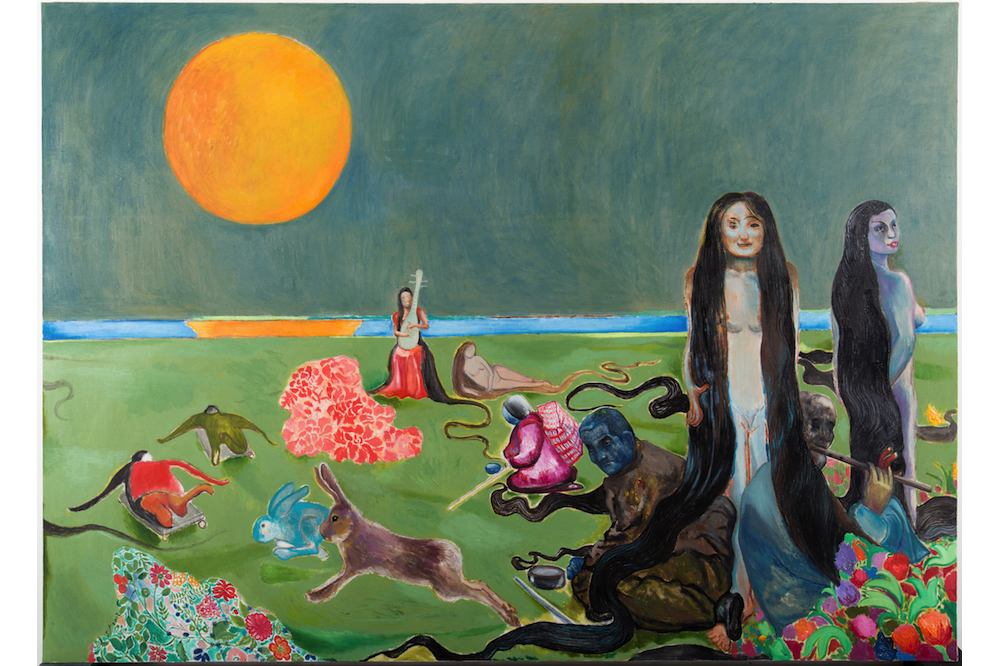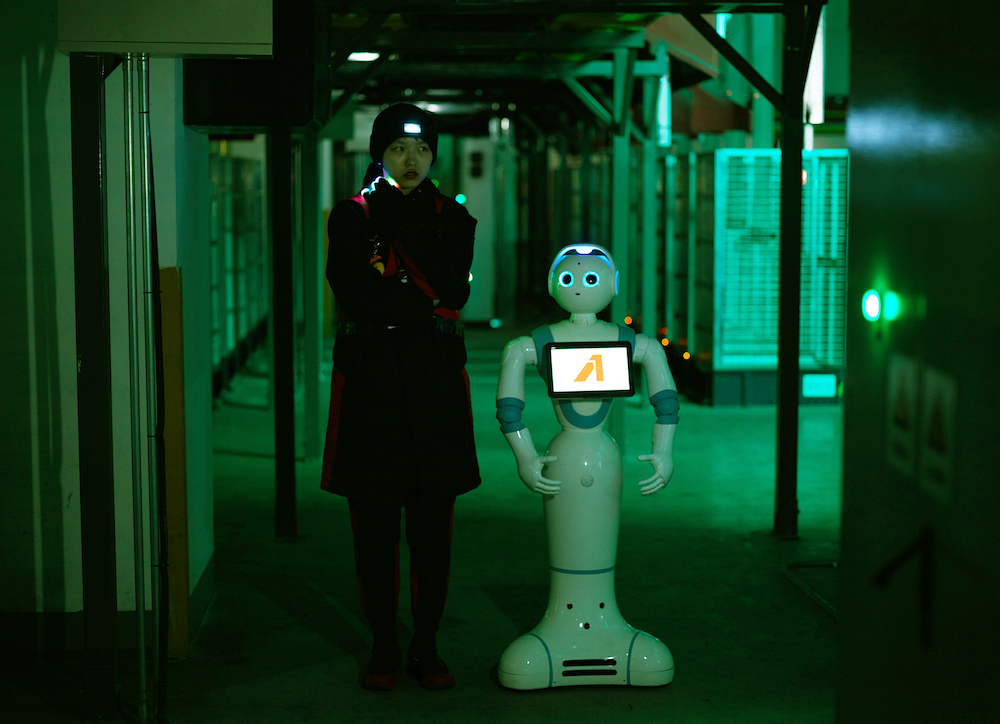In a 1998 New York Times book review, American historian Stephen Greenblatt recalled gazing, as a youth, at the landscapes on the Chinese wallpaper that adorned his childhood home. When he traveled to China in the ‘80s as an adult, he pointed his camera at romantic images that he recognized from his parents’ decor – arched bridges, pagodas, misty green hills – but was always careful to exclude from his snapshots “whatever did not fit.” This type of confirmation bias prevails in exhibitions of contemporary Chinese art abroad. For the past thirty years that the West has been paying close attention – a fascination confirmed by fervent market booms and blockbuster shows – art made in China has been oversimplified and fetishised as “political” or “reactionary” in some legibly Chinese way. It’s natural but lamentable that we grasp at flimsy connections when facing the unknown.
This is especially true in America, where a residual Cold War mentality and competition for global supremacy has bolstered the Trumpian myth: China as an omnivorous monster rousing from political inconsequence to devour the Earth. In China, the same future-focused rhetoric is amplified by the one-party government’s domestic propaganda. Ideological differences on issues such as fair political competition and freedom of speech may drive the axe deeper into the rift, but let us not forget that it was the Spartan’s fear of the rise of Athens that kindled their war.
It was in this tense atmosphere that the future-focused exhibition One Hand Clapping opened at the Guggenheim in New York City in early May. With works by Mainland Chinese-born Duan Jianyu, Lin Yilin, Cao Fei, and Hong Kong-born artists Samson Young and Wong Ping, the show is the third and final installment of the Guggenheim’s Robert H. N. Ho Family Foundation Chinese Art Initiative. Designed to challenge assumptions about Chinese art through curatorial residencies, commissions, and exhibitions, the Initiative is headed by associate curator Xiaoyu Weng, who previously held positions as program director at Kadist Art Foundation and the Asian Contemporary Art Consortium in San Francisco; with consultation from Rome’s MAXXI artistic director, Hou Hanru.
One Hand Clapping follows on the heels of the group exhibition Tales of Our Time (2016–17), which examined notions of place and nation-state through the works of nine artists born in “Greater China” (defined by the curators as Taiwan, Macao, Hong Kong, and the PRC). While praised by some as an important widening of the museum’s perspective, the show was also criticized for confining its artists within in a “geographical straightjacket,” positioning them solely as commentators on the social conditions of their countries of origin. Cognizant of this response in her essay for One Hand Clapping’s catalogue, Weng acknowledged that by virtue of exhibiting in America, the artists “are presented and interpreted in a foreign context…but are expected to project back” to their homelands, and that no exhibition could purport to entirely represent China or Chinese-ness. Instead, she distances herself from straightforward meaning and allows that One Hand Clapping may pose more questions than it answers, seeing the show as a series of complex, experimental dialogues.
Wong Ping’s recorded voice bleeds into the hallway leading to the exhibition; speaking in deadpan Cantonese, the young artist narrates his newest hyper-sexual tragicomedy Dear, can I give you a hand? (all works 2018). The 13-minute animation features Wong’s idiosyncratic psychedelic hues and geometric shapes; erect penises appear often as perfect circles atop rectangles, like a child’s wooden blocks. The video – through a raunchy narrative merging panty-sniffing with middle-aged sex-workers – relays the end-of-life experiences of a libidinous elderly man who lusts after his daughter-in-law after she and his son move into his flat. Such multigenerational cohabitation is common in Hong Kong where housing is astronomically expensive and social security for the elderly is seriously lacking. While many Chinese blessings invoke longevity, long life is often difficult to pay for. Despite the video’s jocular tone, the old man’s dwindling independence is also akin to what many Hong Kongers feel about their political situation as the PRC increasingly asserts its authority in the former British colony. After his death, the elder is quickly forgotten when his family misplaces the password needed to login and carry out traditional tomb-sweeping rituals online – an actual practice in China, and signpost of changing times.
Duan Jianyu’s series of naive-looking paintings (Spring River in the Flower Moon Night) teem with similarly marginal figures: beggars, jugglers, men riding wheeled planks, hairy beasts, and long-haired lute-playing hippies. Like Wong’s old-timer, Duan’s oddball characters represent those deemed economically impotent by a technocratic society. The title of the series is informed by Tang-dynasty literary motifs, but to a younger audience the works may also recall wuxia, the fantastical literary genre in which chivalrous lower-class heroes fight for righteousness in a dystopian version of ancient China. Like those escapist books, popular with youths across China, Duan generates imaginary spaces where outcasts live freely on the outskirts of a rigid, homogeneous society.
Another hypothetical realm awaits in Guangzhou-born artist Lin Yilin’s three-part multimedia installation where visitors don VR goggles and find themselves alone on a basketball court with Taiwanese-American NBA star Jeremy Lin. Startlingly, viewers assume the nauseating, whirling perspective of the ball rather than the athlete as he dribbles and shoots. Pointing at VR technology’s oft-cited capacity to foster human empathy, Lin stretches the notion to an absurd extreme by assigning perspective to an inanimate object. Riffing on the basketball theme, a second video shows a drone hovering at the centrum of the Guggenheim’s cochlear walkway and repeatedly dropping a ball with a delicious, deafening bang. The final video shows the artist tediously pencil-rolling upwards along same empty spiral. As his clothes collect dust, Lin’s body garners far more pathos, and recalls Taiwan-born Tehching Hsieh’s influential 1980s works – also executed in New York – in which the artist performed laborious tasks to visualize the toll of time on the immigrant body.
A different loneliness pervades the work of Cao Fei, known for surreal films that reflect the chaos of a rapidly modernizing Chinese society. Set in an automated e-commerce sorting center, her hour-long film Asia One tells the story of the facility’s lone two workers tasked with supervising the self-sufficient machines: an eerie reminder that today’s dehumanizing labor will one day not be human at all. The film splices in bizarre scenes of dancing workers dressed like Cultural Revolution-era opera characters on the facility’s conveyer belts, alluding to the propagandistic music of the same epoch, which romanticized the radical potential of mechanization. (“Listen to the party, committed to automation, our prospects beautiful as a painting!”) But while industrial progress was coupled with the promise of emancipation, the capitalist exploitation of technology on a grand scale has made existence even more alienating than before.
The bleak mood is temporarily assuaged by jazzy emissions from Samson Young’s installation Possible Music #1 (feat. NESS & Shane Aspegren). Exploring the socio-political underpinnings of sound, Young has become something of an emblem of Hong Kong art in recent years (he represented the territory in last year’s Venice Biennale). For this show, in collaboration with a laboratory for the physical modeling of computer music at the University of Edinburgh, Young hypothesized impossible trumpets that could never be played in reality, including one that requires 300-degree Celsius breath (demonstrated in short animation by a fiery-mouthed dragon). He composed a series of songs with the instruments, which emanate from ten flower-adorned speakers on the ground. Enormous, 3D-printed and pastel-colored segments of the imagined trumpets hang high on the walls at odd angles. In one corner of the room, a video monitor displays the lyrics to the slave protest song “God’s Gonna Cut You Down,” a tune that has often been covered by non-black artists like Johnny Cash, Elvis Presley, and Marilyn Manson, and thus repeatedly severed from its initial context.
This subtle instance of cultural mistranslation recalls the exhibition’s title, excerpted from an ancient riddle which asks “we know what two hands clapping sounds like, but what about one hand clapping?” The unanswerable question was originally posed by Zen Buddhists to test the limits of logical thinking, but has since been appropriated as the title of American Beat novels and rock albums bearing little to no connection to its original roots. Such distortion, reminiscent of the racistly-titled childhood game “Chinese Whispers,” points to the way meaning that is fabricated and misconstrued when transmitted through unreliable channels.
But who, then, is authorized to relay meaning? The Guggenheim’s Chinese Art Initiative was made possible by a hefty 2013 donation from the Robert H. N. Ho Family Foundation, a wealthy Hong Kong philanthropic organization which widely funds the “fostering [of] Chinese culture and Buddhist insights” at many international cultural institutions. Though the curators rightly aim to resist nationalistic interpretation, the segregating of Chinese-born artists from others in discrete exhibitions limits cross-cultural exchange – and it is important to note that the project’s funding was established on such partitions.
The exhibition is noteworthy for its wit and the darkly comedic vein running through the heterogeneous works. Yet One Hand Clapping – despite its V.R., drones, obsolescence-anxiety, automation and surveillance – is not particularly futuristic. Rather, it roots itself firmly in the technological and social conditions of the present. In his aforementioned 1998 review of Jonathan D. Spence’s book “The Chan’s Great Continent: China in Western Minds,” Greenblatt refers to “glimpses of the Other” which are “fleeting, intermittent and partial, sufficient perhaps to get one’s bearings…but not nearly enough to take in the whole.” This exhibition is a similar reminder that looking forward – both across time and borders – is prohibitively periscopic: we can only manage a brief glance at a time.






























1 Comment